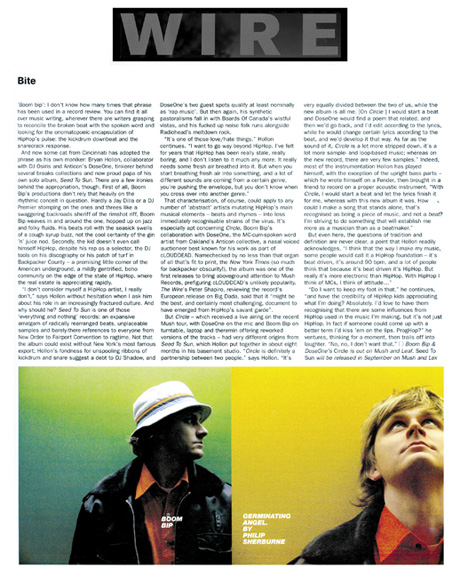
BITE
'Boom Bip': I don't know how many times that phrase has been used in a record review. You can find it all over music writing, wherever there are writers grasping to reconcile the broken beat with the spoken word and looking for the onomatopoeic encapsulation of HipHop's pulse: the kickdrum downbeat and the snarecrack response.
And now some cat from Cincinnati has adopted the phrase as his own moniker: Bryan Hollon, collaborator with DJ Osiris and Anticon's Doseone, tinkerer behind several breaks collections and now proud papa of his own solo solo album, Seed To Sun. There are a few ironies behind the appropriation, though. First of all, Boom Bip's productions don't rely that heavily on the rhythmic conceit in question. Hardly a Jay Dilla or a DJ Premier stomping on the ones and threes like a swaggering backroads sheriff of the rimshot riff, Boom Bip weaves in and around the one, hopped up on jazz and folky fluids. His beats roll with the seasick swells of a cough syrup buzz, not the cool certainty of the gin 'n' juice nod. Secondly, the kid doesn't even call himself HipHop, despite the rep as a selector, the DJ tools on his discography or his patch of turf in Backpacker County -- a promising little corner of the American underground, a mildly gentrified, boho community on the edge of the state of HipHop, where the real estate is appreciating rapidly.
"I don't consider myself a HipHop artist, I really don't," says Hollon without hesitation when I ask him about his role in an increasingly fractured culture. And why should he be? Seed To Sun is one of those 'everything and nothing' records: an expansive amalgam of radically rearranged beats, unplacable samples and barely-there references to everyone from New Order to Fairport Convention to ragtime. Not that the album could exist without New York's most famous export; Hollon's fondness for unspooling ribbons of kickdrum and snare suggest a debt to DJ Shadow, and Doseone's two guest spots qualify at least nominally as 'rap music'. But then again, his synthetic pastoralisms fall in with Boards Of Canada's wistful vistas, and his fucked up noise folk runs alongside Radiohead's meltdown rock.
"It's on of those love/hate things," Hollon continues. "I want to go way beyond HipHop. I've felt for years that HipHop has been really stale, really boring, and I don't listen to it much anymore. It really needs some fresh air breathed into it. But when you start breathing fresh air into something, and a lot of different sounds are coming from a certain genre, you're pushing the envelope, but you don't know when you cross over into another genre."
That characterisation, of course, could apply to any number of 'abstract' artists mutating HipHop's main musical elements -- beats and rhymes -- into less immediately recognisable strains of the virus. It's especially apt concerning Circle, Boom Bip's collaboration with Doseone, the MC-cum-spoken word artist from Oakland's Anticon collective, a nasal voiced auctioneer best known for his work as part of cLOUDDEAD. Namechecked by no less than that organ of all that's fit to print, the New York Times (so much for backpacker obscurity!), the album was one of the first releases to bring aboveground attention to Mush Records, prefiguring cLOUDDEAD's unlikely popularity. The Wire's Peter Shapiro, reviewing the records European release on Big Dada, said that it "might be the best, and certainly most challenging, document to have emerged from HipHop's savant-garde".
But Circle -- which received a live airing on the recent Mush Tour, with Doseone on the mic and Boom Bip on turntable, laptop and theremin offered reworked versions of the tracks -- had very different origins from Seed To Sun, which Hollon put together in about eight months in his basement studio. "Circle is definitely a partnership between two people," says Hollon. "It's very equally divided between the two of us, while this new album is all me. [On Circle] I would start a beat and Doseone would find a poem that related, and then we'd go back, and I'd edit according to the lyrics while he would change certain lyrics according to the beat, and we'd develop it that way. As far as the sound of it, Circle is a lot more stripped down, it's a lot more sample- and loop-based music; whereas on the new record, there are very few samples." Indeed most of the instrumentation Hollon played himself, with the exception of the upright bass parts -- which he wrote himself on a Fender, then brought in a friend to record on a proper acoustic instrument." With Circle, I would start a beat and let the lyrics finish it for me, whereas with this new album it was, How could I make a song that stands alone, that's recognised as being a piece of music, and not a beat? I'm striving to do something that will establish me more as a musician than as a beatmaker."
But even here, the questions of tradition and definition are never clear, a point that Hollon readily acknowledges. "I think that the way I make music, some people would call it a HipHop foundation -- it's beat driven, it's around 90 bpm, and a lot of people think that because it's beat driven it's HipHop. But really it's more electronic than HipHop. With HipHop I think of MCs, I think of attitudeÉ"
"Do I want to keep my foot in that," he continues, " and have the credibility of HipHop kids appreciating what I'm doing? Absolutely. I'd love to have them recognising that there are some influences from HipHop used in the music I'm making, but it's not just HipHop. In Fact if someone could come up with a better term I'd kiss 'em on the lips. Proghop?" he ventures, thinking for a moment, then trails off into laughter. "No, no, I don't want that."
PHILIP SHERBURNE